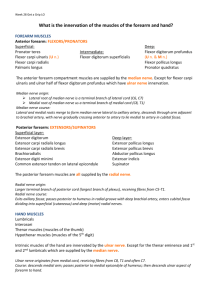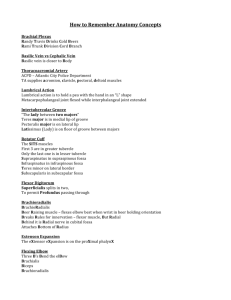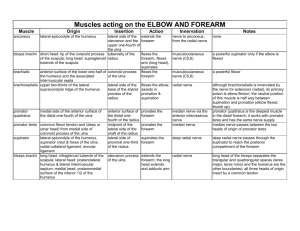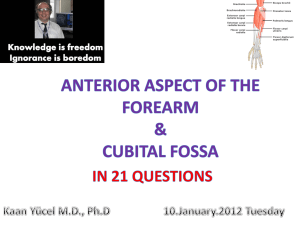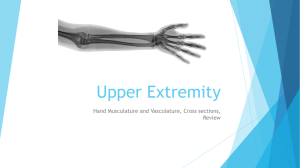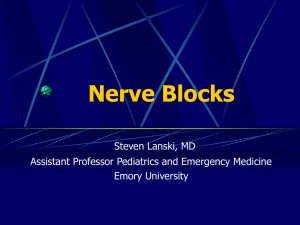Upper Limb VIVA's
advertisement
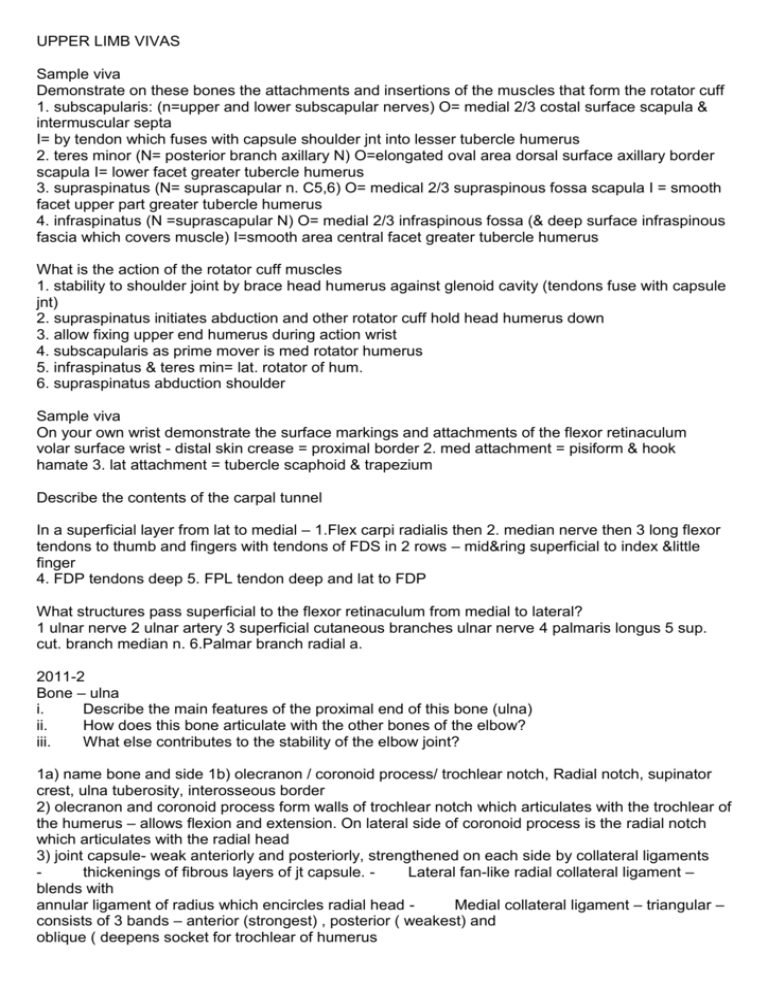
UPPER LIMB VIVAS
Sample viva
Demonstrate on these bones the attachments and insertions of the muscles that form the rotator cuff
1. subscapularis: (n=upper and lower subscapular nerves) O= medial 2/3 costal surface scapula &
intermuscular septa
I= by tendon which fuses with capsule shoulder jnt into lesser tubercle humerus
2. teres minor (N= posterior branch axillary N) O=elongated oval area dorsal surface axillary border
scapula I= lower facet greater tubercle humerus
3. supraspinatus (N= suprascapular n. C5,6) O= medical 2/3 supraspinous fossa scapula I = smooth
facet upper part greater tubercle humerus
4. infraspinatus (N =suprascapular N) O= medial 2/3 infraspinous fossa (& deep surface infraspinous
fascia which covers muscle) I=smooth area central facet greater tubercle humerus
What is the action of the rotator cuff muscles
1. stability to shoulder joint by brace head humerus against glenoid cavity (tendons fuse with capsule
jnt)
2. supraspinatus initiates abduction and other rotator cuff hold head humerus down
3. allow fixing upper end humerus during action wrist
4. subscapularis as prime mover is med rotator humerus
5. infraspinatus & teres min= lat. rotator of hum.
6. supraspinatus abduction shoulder
Sample viva
On your own wrist demonstrate the surface markings and attachments of the flexor retinaculum
volar surface wrist - distal skin crease = proximal border 2. med attachment = pisiform & hook
hamate 3. lat attachment = tubercle scaphoid & trapezium
Describe the contents of the carpal tunnel
In a superficial layer from lat to medial – 1.Flex carpi radialis then 2. median nerve then 3 long flexor
tendons to thumb and fingers with tendons of FDS in 2 rows – mid&ring superficial to index &little
finger
4. FDP tendons deep 5. FPL tendon deep and lat to FDP
What structures pass superficial to the flexor retinaculum from medial to lateral?
1 ulnar nerve 2 ulnar artery 3 superficial cutaneous branches ulnar nerve 4 palmaris longus 5 sup.
cut. branch median n. 6.Palmar branch radial a.
2011-2
Bone – ulna
i.
Describe the main features of the proximal end of this bone (ulna)
ii.
How does this bone articulate with the other bones of the elbow?
iii.
What else contributes to the stability of the elbow joint?
1a) name bone and side 1b) olecranon / coronoid process/ trochlear notch, Radial notch, supinator
crest, ulna tuberosity, interosseous border
2) olecranon and coronoid process form walls of trochlear notch which articulates with the trochlear of
the humerus – allows flexion and extension. On lateral side of coronoid process is the radial notch
which articulates with the radial head
3) joint capsule- weak anteriorly and posteriorly, strengthened on each side by collateral ligaments
thickenings of fibrous layers of jt capsule. Lateral fan-like radial collateral ligament –
blends with
annular ligament of radius which encircles radial head Medial collateral ligament – triangular –
consists of 3 bands – anterior (strongest) , posterior ( weakest) and
oblique ( deepens socket for trochlear of humerus
2011-2
Photo: axilla/brachial plexus
i.
Please identify the muscles in this photo of the axilla
ii.
Identify the components of the brachial plexus.
iii.
What are the terminal branches of medial cord?
2 biceps, 3 coraco-brachialis, 23 subscapularis, 4 Deltoid, 9 Lat Dorsi, 24 Teres major, 10 long head
triceps, 15 medial head triceps, 19 pec minor
26 Ulnar Nerve, 13 med brachial (cutaneous n of arm), 14 med antebrachial (cutaneous n of
forearm), 18 Musculocutanoeus nerve, 21 Radial nerve, 1 Axillary nerve, 17 Median Nerve, 25
Thoracodorsal Nerve, 20 Posterior cord, 12 Medial Cord, 6 Lateral cord.
Ulnar, medial cutaneous nerves of arm and forearm (medial brachial and medial ante-brachial),
medial pectoral nerve, 16 medial root of median nerve
2011-2
Discussion: Sensation Ring finger
Please describe the sensory innervations of the hand.
Ulnar nerve: ulnar 1.5 digits Med nerve: radial 3.5, with wrap over onto dorsum Rad nerve: dorsum
2.5
What dermatomes are represented on the hand
C6 radial side, C7 middle, C8ulnar side
What are the landmarks of the median nerve at the wrist?
FCR and Palm long at prox wrist crease.
2011-2
Photo: Axilla
Please describe the boundaries of the axilla
Lots of structures removed, and some candidates will struggle..need good description of 4/6 Base:
gone! Ax skin, fascia etc Apex: cervicoaxillary canal, cant be seen, passage betw neck and axilla
Ant wall: gone! Pec major/minor and clavipec fascia. Post wall: Scapula and subscap on its surface,
and inf by lat dorsi and teres major Lat wall: cant be seen, inter tub groove in humerus Med wall:
thoracic wall, serratus ant
What are the contents of the axilla?
Axillary artery, in 3 parts defined by pec minor Axillary vein:formed brachial and basilic, becomes
sublav at lat border 1st rib Brachial plexus Axillary lymph nodes: pectoral, subscap, humeral, central,
apical Fat
2011-1
Model: Elbow joint/forearm
Demonstrate and describe on the model the movements of supination and pronation
Prompt: What structures are involved?
What muscles are involved in supination and pronation?
What nerves are involved in supination and pronation?
Rotation of the head of radius in annular ligament Radius rotates laterally around its axis Distal radioulnar joint is the pivot for the rotatory movement Both movements and name annular ligament
Supination: Supinator, Biceps, plus EPL and ECRL Pronation: Pronator teres, Pronator quadratus
Supination: Radial, Musculocutaneous, (deep branch of radial to Sup) Pronation: Median, (ant
interosseous br to PQ)
2011-1
Hand muscles
Describe the muscles of the thenar eminence and their function
APB (abduction and opposition) opponens policis (opposes thumb, draws thumb metacarpal medially
to centre of palm and rotates it medially) FPB (flexion)
What is their innovation
Median (recurrent branch) Deep branch of ulnar
2011-1
Xray hand/ wrist
Identify the bones of the carpus on this Xray
(prompt “carpus” if start with other bones)
Scaphoid/lunate/triquetrum/ pisiform/ hamate/ capitate/ trapezoid/trapezium
Identify the bones of the carpus on the lateral view
Lunate, Capitate and one other
2010-2
Model: Hand
Could you please identify the muscular structures visible in the hand of this model? (Prompt away
from thenar/hypothenar muscles)
Potentially 10 ..3 thenar (op, apb, fpb) 3 hypothenar (adm, fdmb, odm), Add Poll, Lumbrical, Dorsal
and palm int 6/10
Could you demonstrate the actions produced by the lumbricals and the interossei and describe their
innervation?
Lumbs do Z, and PAD/ DAB for interossei, along with extension.. actions are combined to produce Z
All deep br ulnar, except for lat 2 lumbs..median nerve..,
Could you demonstrate the origins and insertions of the short muscles of the hand?
Lumb..orgn1,2 lat side of lat 2 tendons of fdp, 3, 4 bipennate from med 3 tend fdp, dors int orgn
bipenn from adjacent mc’s, insert base prox ph, ext expans, palm int palm surface 2,4,5 mc, ins as
for dors, 2,4,5
2010-2
Model Thumb
Could you please identify the muscles of the thenar eminence, and demonstrate their origins and
insertions?
APB, FPB, OP (all originate fl ret and scaphoid/trap tubercles) apb inserts lat side base prox phal, op
inserts lat 1st mc, and both heads fpb insert lat prox phal. Base
Please demonstrate the movements produced by the thenar muscles. What nerves innervate these
muscles?
Op opposes (mc to middle palm, rotates), abd abducts, helps opposition, fl flexes..all recurrent br.
Med n, except dp hd fpb...deep br ulnar
2010-2
L wrist & hand photo
Identify the median nerve in this photo and adjacent structures.
16. Median n (15. Flexor retinaculum (anterior) – divided) 12. Flexor digitorum superficialis (posterior)
14. Flexor pollicis longus (lateral) 11. Flexor digitorum profundus (deep posterior) 18. palmar
cutaenous branch of median n
Demonstrate where sensation changes may occur if the median nerve is injured in the forearm.
Palmar 3 1⁄2 digits, adjacent palm and dorsal distal fingers
Demonstrate these changes if the median nerve is compressed in carpal tunnel syndrome
Same, except palmar area is preserved (palmar cutaneous branch arises proximal to flexor
retinaculum
2010-2
Photo: Cubital fossa
Identify the contents of the cubital fossa shown in this photograph.
(Boundaries - PT, BR, line b'n epicondyles.) Contents - Median n, Brachial a, Biceps tendon, Radial
n, veins with Brachial a
Demonstrate the course and branches of the Radial nerve, and name the structures they supply
Radial n under BR muscle laterally, divides into superficial and deep, former through Supinator to
post. compt. muscles/jt., lateral to ant. compartment forearm sensory only to dorsum han
Which veins in the cubital fossa are usually accessed during venepuncture? What are the commonly
observed variations to these vessels?
Median cubital, Basilic and Cephalic v's Median basilic and median cephalic in 20%
2010-1
Photo: Brachial Plexus with vessels removed
Identify the components of the brachial plexus as shown in this photo. The vessels have been
removed
Posterior Cord
Radial Nerve (Terminal br)
Axillary Nerve (Terminal br)
Thoracodorsal n
Upper and Lower Subscapular nn
Lateral Cord
Musculocutaneous n (terminal br)
Lat root of median n (terminal br)
Medial Cord
Ulnar nerve (Terminal Br)
Med root of median nerve (terminal br)
Medial cut nn of arm and forearm
Median nerve
Identify the muscles visible in this photo
Surrounding muscles:
Deltoid
Biceps,
coracobrachialis,
pec minor,
triceps,
lat dorsi,
subscapularis,
teres major
2010-1
Model: Elbow Joint
Demonstrate the bony features of the elbow joint
Humerus
Olecranon of ulna
Radial head
Other features are
coronoid of Ulna,
Trochlea,
Capitulum,
lateral and medial epicondyles,
olecranon fossa,
coronoid fossa
Demonstrate the capsular attachments of the elbow
Fibrous layer: surrounds whole joint, proximally above the coronoid and olecranon
fossae, distally across neck of radius and adjacent ulna.
Synovial layer, lines the internal surface of fibrous layer and non articular parts of the
humerus….is continuous distally with synovial membrane of prox radioulnar joint
Describe the collateral ligaments of the elbow
Radial
lat epicondyle of humerus and blends distally with annular ligt of radius.
Ulnar (medial epicondyle of humerus connects to)
1) coronoid tubercle (anterior band)..strongest
2) Posterior fan like band weakest and
3) slender oblique band
Describe the movements of the elbow joint
Flexion
Extension
Pass criteria:
Both to pass
NOTE: Pronation/supination is critical error
2010-1
Photo: Upper Limb
Describe the superficial venous drainage of the upper limb
2009-2
Please identify this bone and its main features
Humerus
Proximal: Head, anatomical & surgical neck, greater and lesser tubercles,
intertubercular groove, deltoid tuberosity, groove for radial nerve,
Distal: condyles, epicondyles, trochlea, capitellum, coronoid and olecranon fossae
Pass criteria:
6/8 proximal to pass
5 distal to pass
What factors stabilise the shoulder joint?
Bones –unstable, glenoid labrum helps.
Ligs: Intrinsic. glenhumeral ligs – ant, weak. Coracohum lig stronger, lies superiorly.
Extrinsic support by coraco-acromial lig. Superiorly
Pass criteria:
Name bone/muscle/lig concept
ID bones as weakest part and muscles as most important
Demonstrate the attachment of the rotator cuff muscles on the humerus
Muscles: rotator cuff muscles (SITS) stabilise superiorly. AP stability from TMaj, LD, Pec Maj
Name and ID attachment 3 of 4 RC muscles
2009-2
Model: Arm. Extensor group of forearm muscles
Identify the extensor muscles of the forearm at the level of the wrist
APL 23, epb 22
ECRL 19, ecrb 18
EPL 21
ED 27, ei
EDM
ECU 16
What is the nerve supply of this compartment?
Radial nerve and its deep branch becoming post interosseus nerve
Describe how the action of these muscles produces thumb movement
APL abduction and extension at carpometacarpal joint
EPL extension at IP joint
EPB extension at MCP
2009-2
Xray : AP/lateral Wrist
Please identify the bones on these Xrays
Ulna/ulnar styloid , radius/radial styloid . Scaphoid, lunate, triquetral, pisiform.
Trapezium, trapezoid, capitate, hamate, metacarpals/phalanges
Pass criteria:
All carpal bones on AP and 2 others to pass, plus capitate/lunate/distal radius on
lateral
What movements occur at the wrist joint?
Flexion >extension. Add>Abduction Circumduction
2009-1
Describe the palmar fascial spaces
What are the contents of the central fascial compartment of the palm
What are the boundaries of the central tascial compartment of the palm
2009-1
Bone: clavicle
This is a right or left clavicle, demonstrate the muscular attachments of this bone
What are the anatomical relations of the medial third of the clavicle
Describe the course of the subclavian vein
2009-1
Discussion
Describe the drainage of the superficial lymphatics of the upper limb
Describe the drainage of the deep lymphatics of the upper limb
How do the right and left subclavian lymphatic trunks drain
2009-1
Photo: extensor retinaculum
On this photo identify the structures bound by the extensor retinaculum
What is the motor supply of these muscles
Describe the sensory supply of the dorsum of the hand
2008-2
Demonstrate the bony features on these X-Rays
Elbow joint
Distal Humerus: Med and lat epicondyles*, trochlea and capitulum*, olecranon fossa
Prox. Radius: Radial head* and neck, prox. radio- ulnar joint, biceps tuberosity
Prox. Ulna: Coronoid process, trochlear notch, olecranon*
Indicate the common extensor origin and name the muscles that arise from it.
Lat. Epicondyle*
Ext. carpi radialis brevis Ext. digitorum Ext. digiti minimi Ext carpi ulnaris
Others that arise from lat epicondyle: anconeus and superficial head of supinator
2008-2
Discussion
What are the dermatomes of the upper limb? Prompt to demonstrate on own arm
What is the peripheral nerve supply to the skin of the hand? (Forearm as bonus)
C 3,4: base of neck, lateral over shoulder C5: lateral arm C6: lateral forearm and thumb C7 middle
and ring(or mid 3) fingers and middle post surface of limb
C8: Little finger, medial hand and forearm T1: mid forearm to axilla T2: small part of arm and axilla
Forearm: Post cut n of forearm, from radial > post forearm. Med cut n of forearm from medial cord of
B plexus > ant and medial forearm. Lat cut n of forearm, from musculocut > lat forearm
Hand: Radial > base of thumb and lateral dorsum of hand. Ulnar > ulnar 11/2 fingers and palm.
Median > radial palm and 31/2 fingers inc post tips of these.
2008-2
Model: Cubital fossa
Demonstrate the boundaries of the Cubital fossa
Contents:
Describe the course of the brachial artery as it passes through the arm (pull off both upper forearm
muscles from model)
Lateral: medial border of brachioradialis Medial: Lat border of pronator teres Superior: Line between
2 epicondyles of humerus Floor: brachialis
Roof: skin, deep fascia reinforced by bicipital apon.
Med to lat. : median n, brachial art., biceps tendon, radial n deep to brachioradialis
From lower border of teres major(cont. of axillary art) to neck of radius. Medial to humerus > bicipital
groove, post to biceps, anterior to triceps medial head. Comes to lie on brachialis as descends to
cubital fossa. Median nerve crosses anteriorly. Ulnar nerve a post relation in the upper arm
2008-1
Bones of carpus
Identify the bones of the carpus
scaphoid
lunate
trapezium
trapezoid
capitate
hamate
triquetrum
pisiform
Describe the attachments of the flexor retinaculum
(What forms the carpal tunnel?)
Hook of hamate + pisiform medially (= ulnar)
Trapezium (tubercle) + scaphoid (tubercle) laterally
What nerves pass superficial to the carpal tunnel?
Ulnar nerve
Palmar cutaneous branch of median nerve
2008-1
Describe the boundaries of the cubital fossa
Superiorly – imaginary line connecting the epicondyles
Medially – flexor muscles of forearm arising from common flexor attachment & medial
epicondyle (pronator teres)
Laterally – extensor muscles of forearm arising from the lateral epicondyle &
supraepicondylar ridge (brachioradialis)
Floor – brachialis and supinator muscles of the arm & forearm
Roof – deep fascia reinforced by bicipital aponeurosis, subcutaneous tissue and skin
Describe the contents of the cubital fossa
Brachial artery dividing into terminal branches; radial & ulnar arteries. It lies between
Biceps brachii tendon AND Median nerve
Radial nerve – deep between brachioradialis and brachialis, dividing into deep and
superficial branches
(Veins accompanying arteries)
Venepuncture veins (median cubital and medial and lateral antebrachial)
2008-1
Photo
Identify on this specimen the median nerve
Identification of median nerve (numbered 16)
Describe on the course of the median nerve in the forearm, using the photograph where able
Emerges from cubital fossa
Passes between two heads of Pronator teres (PT)
Descends deep to Flexor digitorum superficialis (FDS) (numbered 12) closely attached
to fascial sheath
Continues distally between FDS and Flexor digitorum profundus (FDP)
Becomes superficial at wrist, passing between tendons of FDS and Flexor carpi radialis
(FCR) (numbered 8); deep to Palmaris longus (PL) if present
Passes deep to Flexor retinaculum
What are the structures supplied by the median nerve?
No branches in arm
Articular branches to elbow joint
Muscular branches to PT; FCR; PL; FDS
Anterior interosseus nerve to PQ; FPL; ½ FDP; articular branches to wrist joint
Palmar cutaneous branch to skin of lateral part of palm and adjacent thenar eminence
Recurrent branch to thumb muscles (APB; OP; FPB)
Palmar digital branches to lumbricals 1,2 and cutaneous supply
2007-2
Discussion
Demonstrate the dermatomes of the upper limb
Please describe the cutaneous innervation of the hand
Cutaneous innervation of the rest of the upper limb?
2007-2
Discussion
What is the brachial plexus and how is it formed
Bonus: major peripheral nerves supplying the upper limb
2007-2
Bone:Humerus and scapula
Describe the bony features of the proximal humerus
What factors contribute to stability of the glenohumeral joint
2007-1
What are the boundaries of the anatomical snuffbox?
EPL on the ulnar side
EPB/APL on the radial side
Floor is radial styloid/scaphoid/trapezium/base of thumb MC
What are the contents of the anatomical snuff box?
Radial artery
2) Cutaneous branches of radial nerve
3) Origin of cephalic vein
What tendons run underneath the extensor retinaculum?.
Divides dorsum of wrist into 6 compartments. Going from radial to ulna
APL/EPB are in first compartment, each in sep sheath
radial extensors of wrist ECRL/ECRB each in own sheath
on ulna side of radial styloid, EPL
4 tendons of Ext.Dig over tendon of Ext indicis: common sheath
over the radio-ulnar joint, double tendon of Ext dig minimi
groove near base of ulnar styloid Ext Carpi Ulnaris
2007-1
Median Nerve in Forearm _______ NUMBER: Thurs p.m. 3 ___________
COMMENTS
OPENING QUESTION
Demonstrate the course of the median nerve in the forearm and wrist
COMMENTS Must ID the median nerve +
3/4 muscles/tendons
to pass
POINTS REQUIRED
1 Exits cubital fossa between 2 heads of pronator teres
2 Runs distally adherent to posterior aspect of FDS
3 At wrist emerges between FCR & FDS, just deep + lateral to palmaris longus
4. Deep to the flexor retinaculum
PROMPTS
Show me the median nerve at the wrist. Name the tendons adjacent to it
SECOND QUESTION (if needed)
What muscles does the median nerve supply in the forearm and hand?
Must address muscular and sensory components
POINTS REQUIRED 3 to pass
1 PT, FCR, PL,FDS + elbow + prox radio-ulnar joints
3 to pass
2 Anterior interosseous branch: FDP (index+middle finger bellies), FPL, PQ, inf radio-ulnar, wrist +
carpal joints
3 Palmar branch- supplies skin over thenar eminence
4 Radial 31/2 digits sensation
5 Radial 2 lumbricals
2007-1
Innervation of the arm ______________________
NUMBER:
COMMENTS
OPENING QUESTION
Describe the course of the radial nerve in the upper limb
COMMENTS
POINTS REQUIRED
1 C5-7 branch of posterior cord
2 Leaves axilla
3 Oblique across humerus
4 Heads triceps (bet long and med heads)
__________
5 Spiral groove
6 Pierce intermuscular septum
7 Brachialis / brachioradialis – lies between
8. Ext carpi radialis longus
PROMPTS
SECOND QUESTION (if needed)
Name the major branches of this nerve in the arm
POINTS REQUIRED
1Triceps – long head, lat head, med head
2 Post cutaneous
3 Anconeus
4 lat Cut n of arm
5 Brachioradialis
6 Ext carpi radialis longus
7. Lat brachialis
8. Elbow joint
9. Post interosseous: ECRB and supinator in cubital fossa Ext compartment of forearm ED, EDM,
ECU APL, EPL, EPB Ext indicis
2006-2
Arm – forearm flexors, distal insertions
. Using this model, please identify the muscles in the flexor compartment of the forearm? You may lift
off the detachable segment
Superficial compartment -Pronator teres, FCR, FDS, Palmaris Longus, FCU Deep compartment FDP, FPL, Pronator Quad
2. Please describe and demonstrate the distal insertions of these muscles.
PT..lateral convexity of radius, FCR..base of 1, 2 mcarpals, FDS..base of middle phalanx, PL..palmar
apon, FCU..pisiform, FDP..base of distal phalanx, FPL..base of distal phal, PQ..lat part of radius
2006-2
Flexor retinaculum
On your own wrist demonstrate the surface markings and attachments of the flexor retinaculum
volar surface wrist - distal skin crease = proximal border 2. med attachment = pisiform & hook
hamate 3. lat attachment = tubercle scaphoid & trapezium
Describe the contents of the carpal tunn
in a superficial layer from lat to medial – 1.Flex carpi radialis then 2. median nerve then 3 long flexor
tendons to thumb and fingers with tendons of FDS in 2 rows – mid&ring superficial to index &little
finger 4. FDP tendons deep
5. FPL tendon deep and lat to FDP
What structures pass superficial to flexor retinaculum From medial to lateral
1 ulnar nerve 2 ulnar artery 3 superficial cutaneous branches ulnar nerve 4 palmaris longus 5 sup.
cut. branch median n. 6.Palmar branch radial a.
2006-2
Bone – scapula
and humerus
rotator cuff, origins, insertions, actions
Demonstrate on these bones the attachments and insertions of the muscles that form the rotator cuff
.
1. subscapularis: (n=upper and lower subscapular
nerves) O= medial 2/3 costal surface scapula & intermuscular septa I= by tendon which fuses with
capsule shoulder jnt into lesser tubercle humerus 2. teres minor (N= posterior branch axillary N)
O=elongated oval area dorsal surface axillary border scapula I= lower facet greater tubercle humerus
3. supraspinatus (N= suprascapular n. C5,6) O= medical 2/3 supraspinous fossa scapula I = smooth
facet upper part greater tubercle humerus 4. infraspinatus (N =suprascapular N) O= medial 2/3
infraspinous fossa (& deep surface infraspinous fascia which covers muscle) I=smooth area central
facet greater tubercle humerus
What is the action of the rotator cuff muscles?
1. stability to shoulder joint by brace head humerus against glenoid cavity ( tendons fuse with capsule
jnt) 2.supraspinatus initiates abduction and other rotator cuff hold head humerus down
3.& allow fixing upper end humerus during action wrist 4. subscapularis as prime mover is med
rotator humerus
5. infraspinatus & teres min= lat. rotator of hum. 6. supraspinatus abduction shoulder
2006-1
Bone; Ulna &humerus - Landmarks and articulations of the Ellow NUMBER: Th AM? 2
COMMENTS
OPENING QUESTION
Demonstrate the major bony features of the elbow
COMMENTS
POINTS REQUIRED
1 Humerus: Medical epicondyle, Lateral epicondyle, Capitellum, Trochlea, Cornoid fossa, radial fossa,
Olecranon fossa
5 to pass
2 Ulna: Olecranon, trochlear fossa, Coronoid process, Sublime tuberosity, Supinator crest, Radial notch
4 to pass
3
PROMPTS
SECOND QUESTION (if needed)
Outline the capsular attachments of the humerus
POINTS REQUIRED
1 Medial and lateral margins
Points 3 & 4 to pass
2 Capitellum and trochlea.
3 Above the cornoid and olecranon fossa
4. Excludes epicondyles
2006-1
Cubital Fossa
COMMENTS
NUMBER: Th PM Q3
OPENING QUESTION
Describe the boundaries and contents of the cubital fossa
COMMENTS
POINTS REQUEUED
1 Pronator teres medially
2 Brachioradialis laterally
3 Line between the epicondyles
3. Deep fascia & bicipital aponeurosis - Roof
4 Brachialis, supinator - Floor
1 ,2&3topass
PROMPTS
Perhaps questions of orientation. Tell me what you can see
SECOND QUESTION
(ifneeded
)
What are the contents of the cubital fossa? (medial to lateral)
POINTS REQUIRED
Median N,
Brachial artery
Biceps tendon
Radial nerve
Posterior interosseous branch
2006-1
Humerus - fracture sites and position of nerves NUMBER:
COMMENTS
Fri«2
^
OPENING QUESTION
Identify the main features of the proximal half of this bone
COMMENTS
POINTS REQUIRED
1 Proximal - Head, neck, greater & lesser tuberosity, intertubercular groove.
3/5
2 Mid - shaft, deltoid tuberosity, radial groove.
2/3
3.
4
5
PROMPTS
SECOND QUESTION (if needed)
What are the common sites of fracture in the proximal half of this bone and what nerves are at risk with these
fractures
POENTTS REQUIRED
1 NOH - axillary and brachial plexus
lof
2
2 Midshaft - radial nerve, wrist drop & sensory deficit
2005-2
TOPIC: Median Nerve: Position & distribution distal to elbow NUMBER: 1.1
OPENING QUESTION
Identify the muscles that make up the boundaries of the cubital fossa and its contents.
Pronator teres, medially; brachioradialis laterally, brachialis, base, medial to lateral
Contents: median nerve, brachial artery, biceps tendon
2/3 muscles and 3 contents in correct relationship
SECOND QUESTION (if needed)
Describe the course of the median nerve between the elbow and the wrist
POINTS
REQUHIE
D
1 Leaves cubital fossa between 2 heads of pronator teres
*4/5 to pass
2 Passes deep to fibrous arch of flex dig superficialis. It is adherent to the deep surface of this muscle as it runs
distally.*
3 Above wrist it becomes more superficial between tendons of flex carpi radialis and flex dig superficialis *
4 Lies behind and slightly lat to tendon of palmaris longus *
5 Passess under flexor retinaculum*
TRTRD QUESTION
Describe the branches of the median nerve in the forearm and what they supply
1 Muscularbranchesneartheelbow 1) Branch to pronator teres* 2) Branch to flexor carpi radialis* 3) Branch to
palmaris longus*
4) Branch to flexor dig superficialis *(nb. Branch to index finger part of this mm arises in middle of forearm)
To Pass: Anterior interosseous + palmar cutaneous + 5 of 7 muscles supplied.
2 Branches to elbow joint and proximal radio-ulnar jt*
3 Anterior interosseus branch Given off deep to FDS. Runs down with aa of same name Supplies Flex dig
profundus (usually bellies for index and middle fingers)
Flex poll longus Pronator quad Inferior radio-ulnar joint
Wrist and carpal joints
4 Palmar branch*
DE08a Anatomy Viva workshop.rt
fGiven
off in distal forearm, runs above flex ret, supplies skin over thenar muscles
2005-2
Median Nerve: Position & distribution distal to elbow NUMBER: 2.5
COMMENTS
FIRST QUESTION
Describe the course of the median nerve distal to the elbow
COMMENTS
POINTS REQUIRED
1 Leaves cubital fossa between 2 heads of pronator teres
*
2 Passes deep to fibrous arch of flex dig superficialis. It is adherent to the deep surface of this muscle as it runs
distally.*
3 Above wrist it becomes more superficial between tendons of flex carpi radialis and flex dig superficialis *
4 Lies behind and slightly lat to tendon of palmaris longus*
5 Passes under flexor retinaculum between FDS tendon to middle finger and FCR tendon to enter hand *
SECOND QUESTION
What are the branches of the median nerve distal to the flexor retinaculum and what do they supply?
POINTS REQUIRED
Gives muscular branch (recurrent) which curls proximally around distal border of flexor ret. to supply thenar*
mm.
*essential
Medial branch Divides again into 2 and supplies the palm skin*, the cleft and adjacent sides of ring and middle
fingers and the cleft and adjacent sides of middle and index fingers. This latter branch also supplies the second
lumbrical Lateral branch Supplies palmar skin, radial side of index, the whole of the thumb and it's web on the
palmar surface and the distal part of the dorsal surface. The branch to the index finger supplies the first
lumbrical. These palmar digital branches also supply the nail beds and distal dorsal skin of the digits
*essential to demonstrate cutaneous distribution
PROMPT
Demonstrate the sensory distribution of the median nerve in the hand.
2005-2
X-ray Hand & Wris
COMMENTS
t
NUMBER: 3.2
OPEMNG QUESTION
Please identify the bones of the carpus
COMMENTS
POINTS REQUIRED
lProx: scap lun triq pis
7/8 identified to pass
2 Dist: trapm, trapd, cap ham
*
PROMPTS
What carpal bones can you identify on this lateral
fdm
?
Lunate and capitate to pass
SECOND QUESTION
Please
describe the attachments
of the flexor retinaculum
POINTS REQUIRED
1 Strong fibrous band 2-3 cm transv & horiz
2 Prox limit at distal, dominant wrist crease
3 Attached to medially: hook of hamate & pisiform
4 laterally: ridge of trapezium & scap tubercle
% bones to pass
PROMPTS
TfflRD QUESTION (if needed)
What structures pass through the carpal tunnel?
POEVTS REQUTRED
1 Carpal tunnel b/w flex, retinae. & carpal bones
2 Median n* & all long flexors of fingers and thumb
*essential
3 4 sup flexors*: mid& ring ant to index&littl
e
*essential
4 profundus deeper* in one plane, FPindicus separate
•essentia
l
5 All 8 tendons in one common flexor sheath, but
6 FPL passes'thru on its own
2005-1
Middle Finge
6
r
NUMBER: 1-4
OPENING QUESTION
What are the tendon attachments of muscles involved in flexion of joints of the middle finger
COMMENTS
POINTS REQUTRED
1 FDS: round FDP tendon/chiasma/insert margin of front middle phalanx
Required
2 FDP Base terminal phalanx
Required
3 Lumbricals Extensor Sheath thence Dorsum proximal phalanx
4 Palmar & Dorsal Interossei (flex MP if work together)
5
6
PROMPTS
SECOND QUESTION (if needed)
What is the nerve supply to these muscles?
POINTS REQUTRED
1 Ant interosseus branch median (middle/ring)
2 to pass
2 Ulnar (ring/little
)
3 60% 2:2 & 40% 3:1/1:3
4 Possible lumbricals by ulna
2005-1
Wrist
NUMBER: 2-3
COMMENTS
OPENING QUESTION
Identify the bones of the carpus
COMMENTS
POINTS
TCEQUTRE
D
1 Scaphoid }
8 of8 to pass
2 Lunate }
(proximal row)
1 prompt acceptable
3 Triquetrium }
4 Pisiform }
5 Trapezium
}
6 Trapezoid
}
(distal row)
7 Capitate }
8 Hamate }
PROMPTS
SECOND QUESTION (if needed)
What are the attachments of the flexor retinaculum?
4 bones to pass
POINTS REQUIRED
1 Hamate and Pisiform medially - piso-hamate lig
2 Trapezium and Scaphoid laterally - crest on trapezium and tubercle of scaphoid
3
PROMPTS
THIRD QUESTION (if needed)
What are the surface markings?
POINTS REQUIRED
1 Distal Volar flexion crease at scaphoid and pisiform
2005-1
Scapul
COMMENTS
a
NUMBER; 3-3
OPENING QUESTION
Identify the major bony features of this bone
COMMENTS
POINTS REQUIRED
1 Spine & Acromiu
m
6of10 topass
2 Supraspinous & Infraspinous fossa
3 Subscapular fossa & Glenoid
4 Tubercle for Long head triceps
5 Tubercle for Long Head Biceps
6 Coracoid process & Supraspinal notch
7
PROMPTS
SECOND QUESTION (if needed)
If needed - Which muscles comprise the rotator cuff?
All 4 named to pass
POINTS REQUIRED
1 Subscapularis (medial 2/3 of subscapular fossa) to lesser tuberosity
2 Supraspinatus(medial 2/3 supraspinous fossa) to upper greater tuberosity
3 Infraspinatus (infraspinous fossa) to middle greater tuberosity
4 Teres Minor (upper lateral border) to lower greater tuberosity
2005-1
Thumb
NUMBER: 3-4
COMMENTS
OPENING QUESTION
What muscles are involved in movement of the thumb?
COMMENTS
POINTS REQUTRED
1 MP Flexion: FPL & Br
2 MP Extension: EPL & Br
3 Palmar abduction: Abductor pollicis brevis
4 Radial Abduction: APL & EPB
5 Ulnar adduction: Adductor Pollicis
6 Flexion abduction: AP & FPB
7 Opposition: Opponens & EPL & Br
PROMPTS
SECOND QUESTION (if needed)
What is the nerve supply to these muscles?
POINTS REQUIRED
1 Adductor Policis: Ulnar (C8)
2 FPB: variable median or ulnar or both
3 Opponens: Both median & Ulnar
4 All the others in thenar emminence -Recurrent branch median nerve (Tl & some C8)
5 Long Tendons - Radial nerve
2004-2
Identify the bones shown on this X Ray
COMMENTS
POINTS REQUIRED
1 Phalanges
7 of 8 Carpal to pass
2 Metacarpals
3 Carpals
4 Radius/Ulna
5
6
7
PROMPTS
Prompt by Pointing
SECOND QUESTION (if needed)
Identify the bones of the Carpus on this lateral
POINTS REQUIRED
1 Lunate
Lunate & capitate to pass
2 Capitate
3 Radius
4
5
6
PROMPTS
THIRD QUESTION (if needed)
Describe the blood supply of the scaphoid
POINTS REQUIRED
1 Vascular Perforators more numerous distally
2004-2
The anterior wall of the axilla has been removed. Show us the components of the p
COMMENTS
POINTS REQUIRED
1 Subscapularis (17)
2 of 3 to pass
2 Teres Major (18)
3 Lattisimus Dorsi (19)
4
5
6
7
PROMPTS
Brachial Plexus / Begin proximally and work distally
SECOND QUESTION (if needed)
What are the branches of this structure? [identify medial cord - 3]
POINTS REQUIRED
1 Medial pectoral nerve
4 of 5 to pass
2 medial root median nerve (9)
3 medial cutaneous nerve of the arm (13)
4 medial cutaneous nerve of the forearm (15)
5 ulna nerve (14)
6
PROMPTS
The Axillary Artery has been removed
THIRD QUESTION (if needed)
What anatomical structures are associated with the various components of the brachial plexus
POINTS REQUIRED
5 roots - behind scalenus anterior
3 trunks – lower part of posterior triangle
A/P divisions - behind clavicle
3 cords - outer border first rib (beginning of axilla)
cords enter above 1st part of artery, approach and embrace its 2nd part, give off branches around its 3rd part
2004-2
On your own arm, demonstrate the dermatomes of the upper limb
COMMENTS
POINTS REQUIRED
1. require C4 at shoulder to T2
3
4
5
6
7
PROMPTS
What cervical and thoracic levels supply skin of the upper limb?
SECOND QUESTION (if needed)
What functional deficit results from a radial nerve injury in the mid arm and explain why?
POINTS REQUIRED
1 Elbow extension preserved – medial and long head triceps
2. wrist drop – inability to extend wrist and MCP jnts of fingers and thumb of muscles of common extensor origin: extension
BR, ECRL, ECRB, ED, EDM, ECU. + deep extensors Aconeus, supinator, ABPL, EPB, EPL, EI
3. Inter phalangeal jnts maintained due to lumbricals and interossei
4. sensory loss usually small over 1st interosseous space (radial 2/3 dorsum of hand)
5
6
PROMPTS
What would you expect at the elbow? What muscles are supplied by radial nerve? What is its sensory distribution?
2004-2
Identify the bony features of the elbow joint on this Xray
COMMENTS
POINTS REQUIRED
1 Humerus – capitulum, trochlea, radial fossa, coronoid fossa, olecranon fossa
3/5 to pass
2 Radius – head, neck
3 Ulna – olecranon, trochlear notch, coronoid process
2/3 to pass
4
5
6
7
PROMPTS
SECOND QUESTION (if needed)
Demonstrate the attachments of the ulnar collateral ligament on the lateral
POINTS REQUIRED
1 Anterior band – medial epicondyle to medial edge of coronoid
2 Posterior band – medial coronoid to medial olecranon
3 Middle band – between anterior & posterior bands
2003-2
X-Ray Elbow
COMMENTS
QUESTIONS AND POINTS REQUIRED
Demonstrate the bony features of the elbow joint: Humerus: epicondyles, olecranon fossa, capitulum, trochlea
Radius: head, neck, tubercle Ulna: olecranon, coronoid process
All to pass
Demonstrate the capsular attachments (AP and lateral films):
Around olecranon, radial and coronoid fossae of humerus Olecranon margins Annular ligament
Articular margins of humerus, olecranon margins and annular ligament to pass
Demonstrate the ligamentous attachments:
Medial collateral – medial epicondyle to olecranon with 3 elements
Lateral collateral – lateral epicondyle to annular ligament
Name the 3 ligaments to pass
2003-2
Hand Vascular
QUESTIONS AND POINTS REQUIRED
On your hand, demonstrate the vascular supply to the hand:
Ulna: superficial palmar arch with common digital to digital arteries to ulnar part of hand
Radial: through snuffbox and between heads of 1st interosseous to form deep palmar arch: princeps pollicis, radialis
indicis, metacarpal, common digital and digital
Dorsal carpal arch and dorsal metacarpal and digital arteries (bonus)
2003-2
Forearm model
QUESTIONS AND POINTS REQUIRED
On this model, demonstrate pronation and supination of the forearm
Demonstrate to pass
Which muscles are involved
Pronation: PQ and PT
Supination: Supinator and biceps to pass
What nerves are required for pronation and supination:
Median for pronation, Musculocutaneous and radial for supination
2003-2
Small muscles of hand
QUESTIONS AND POINTS REQUIRED
Describe the function of the interossei and lumbricals
Flexion at MCPJs, extension at IPJs
What is the nerve supply of these muscles
Interossei: ulnar Lumbricals: Ulnar 2 and median 2
2003-2
Demonstrate the bones of the hand and wrist as seen on this xray {AP)
All to pass
On the lateral view demonstrate the bones of the carpus
Scaphoid, lunate and capitate to pass.
What are the bony attachments of the flexor retinaculum.
Hamate, Trapezium, Scaphoid, Pisiform to pass
2003-1
WHAT ARE THE MAJOR BONEY LANDMARKS OF THE DORSUM OF THE WRIST?
COMMENTS
POINTS REQUIRED
1 DORSAL TUBERCULE ( RADIAL TUBERCULE)
2/2
2 Ulna styloid
3
4
5
6
7
PROMPTS
SECOND QUESTION (if needed)
DESCRIBE THE TENDONS CROSSING THE DORSUM OF THE WRIST
POINTS REQUIRED
1 EDMINIMI EXT. DIGITORUM
ECRL/ECRB ECU EPL/EPB APL
EXT INDICIS
2003-1
Humerus _____________________________NUMBER: 3AM ___________
COMMENTS
OPENING QUESTION
CAN YOU IDENTIFY THE MAJOR LANDMARKS OF THE PROXIMAL HALF OF THIS BONE?
COMMENTS
POINTS REQUIRED
1 head
neck x 2 2 tuberosities bicipital groove (intertubercular) shaft deltoid tuberosity radial/spiral grooves
6 TO PASS
2
3
4
5
6
7
PROMPTS
SECOND QUESTION (if needed)
WHAT ARE THE MAJOR MUSCLES OF SHOULDER ABDUCTION & CAN YOU IDENTIFY WHERE THEY
INSERT?
POINTS REQUIRED
1 Deltoid Deltoid tuberosity
Supraspinatus Greater tuberosity
2003-1
VENOUS DRAINAGE UPPER LIMB ________ NUMBER: 2 ___________
COMMENTS
OPENING QUESTION
CAN YOU DESCRIBE THE VENOUS DRAINAGE OF THE UPPER LIMB
COMMENTS
POINTS REQUIRED
1. SUPERFICIAL & DEEP
4/5 TO PASS
2 SUPERFICIAL: DORSAL VENOUS ARCH TO CEPHALIC & BASILIC VV
3 PALM DRAINS DORSALLY
EXTRA
4 DEEP: CORRESPONDS TO ARTERIES
5 STARTS AS VENAE COMITANTES
PROMPTS
FOR DETAILS OF COURSE OF CEPHALIC VEIN
2003-1
ULNA______________________________ NUMBER: 3PM ___________
COMMENTS
OPENING QUESTION
IDENTIFY THE MAJOR FEATURES OF THIS BONE
COMMENTS
POINTS REQUIRED
OLECRANON/CORONOID/TROCHLEA/RADIAL NOTCH/SUPINATOR CREST/
SUBLIME TUBERCULE
7 FEATURES TO PASS
SHAFT/ ANTERIOR & POSTERIOR BORDERS
DISTALLY: STYLOID
PROMPTS
SECOND QUESTION (if needed)
WHAT MUSCLES ARE INVOLVED IN FLEXION OF THE ELBOW
2/4 TO PASS
POINTS REQUIRED
BICEPS
SUPINATOR
BRACHIORADIALIS
BRACHIALIS
FLEXOR DIGITORUM SUPERFICIALIS
